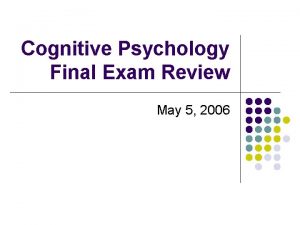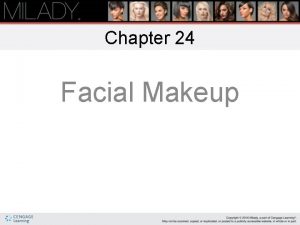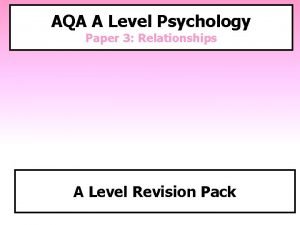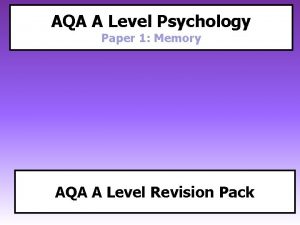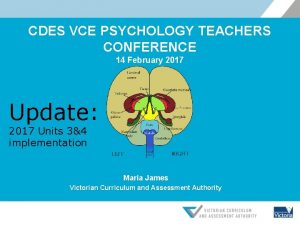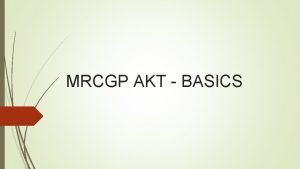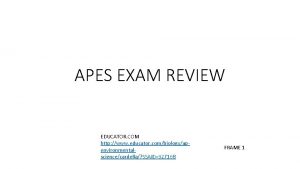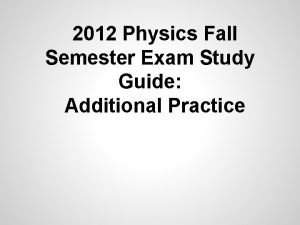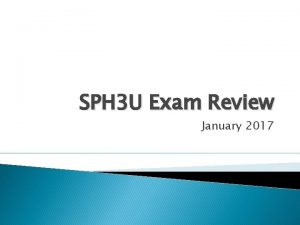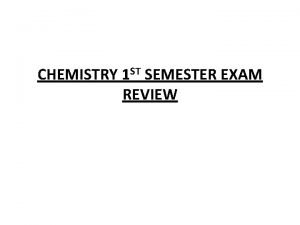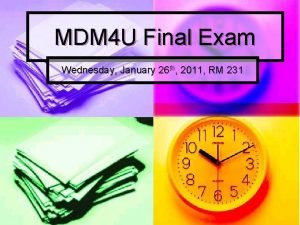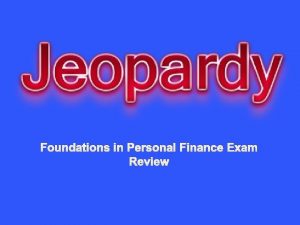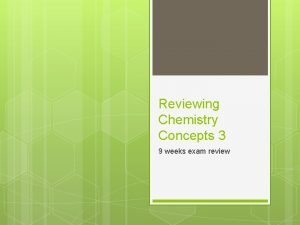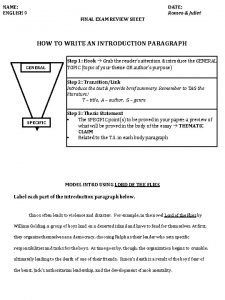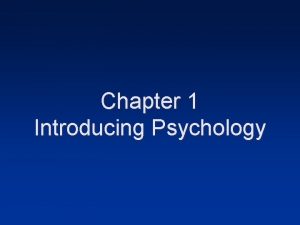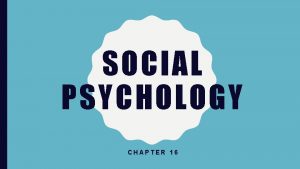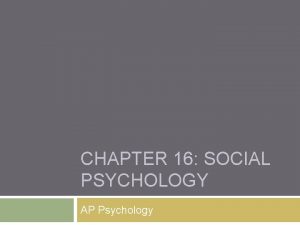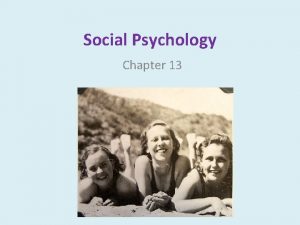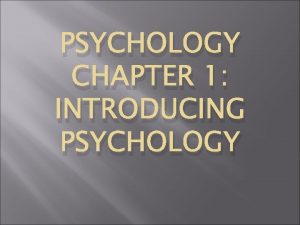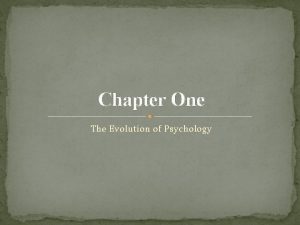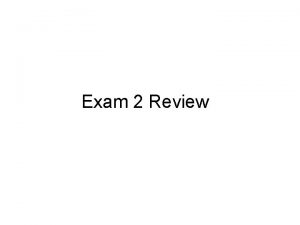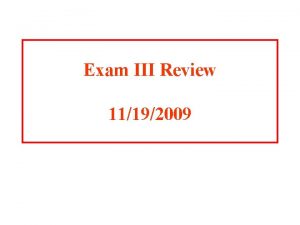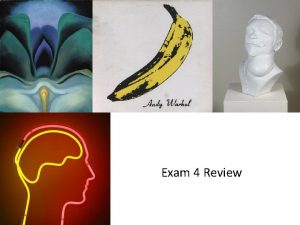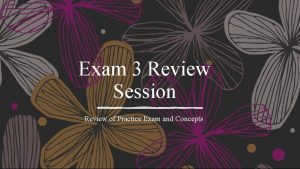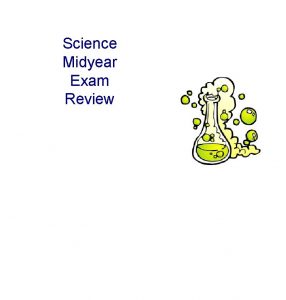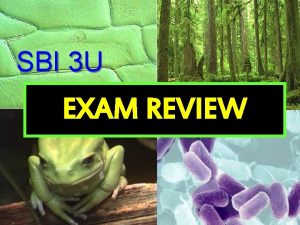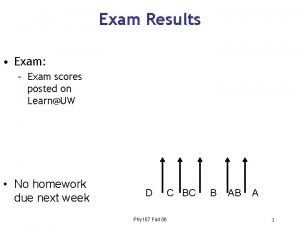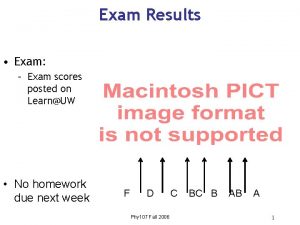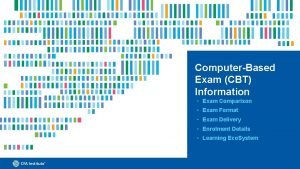AP PSYCHOLOGY Review for the AP Exam Chapter


































![Neural Communication § Synapse [SIN-aps] § junction between the axon tip of the sending Neural Communication § Synapse [SIN-aps] § junction between the axon tip of the sending](https://slidetodoc.com/presentation_image_h/1fe2aae7b162142f13707fe43aa54852/image-35.jpg)

![Neural Communication § Acetylcholine [ah-seat-el-KO-leen] § a neurotransmitter that, among its functions, triggers muscle Neural Communication § Acetylcholine [ah-seat-el-KO-leen] § a neurotransmitter that, among its functions, triggers muscle](https://slidetodoc.com/presentation_image_h/1fe2aae7b162142f13707fe43aa54852/image-37.jpg)


















































































- Slides: 119

AP PSYCHOLOGY Review for the AP Exam Chapter 1 -4

Psychology: The science of behavior (what we do) and mental processes (sensations, perceptions, dreams, thoughts, beliefs, and feelings…. ) At all levels, psychologists examine how we process information--how we organize, interpret, store, and use it.

SCHOOLS OF PSYCHOLOGY Prologue

Prologue: Psychology’s Roots Empiricism § Knowledge comes from experience via the senses § Science flourishes through observation and experiment

Founding Psychologists: 1) William Wundt: (1879 Leipzig, Germany) Founded the first formal laboratory devoted to experimental psychology. 2) Hermann von Helmholtz: physicist who conducted simple experiments on perception and the nervous system…. . the first to measure the speed of a nerve impulse. 3) Herman Ebbinghaus: 1885 published classic studies on memory 4) G. Stanley Hall: first psychology laboratory in US (1883) at John Hopkins Univ…………. . first American Psychology Journal (1887)……. first president of American Psychological Association (1892) 5) Margaret Floy Washburn: First woman to receive Ph. D in Psychology (1894) 6) Francis Cecil Sumner: first African-American Ph. D in psychology 7) Mary Whiton Calkins: first woman elected president of APA, 1905

Historical Schools STRUCTURALISM: using introspection, the systematic examination by individuals of their own thoughts and feelings about specific sensory experiences. Emphasized the structure of the mind and behavior. Edward Titchener: (Cornell University) emphasized the “what” of mental illness rather than “why” or “how” of thinking. The major opponent to Stucturalism was…… FUNCTIONALISM: FUNCTIONALISM gives primary importance to learned habits that enable organisms to adapt to their environment and to function effectively. “What is the function or purpose of any behavioral act? ” John Dewey: provided impetus for progressive education. William James: study of consciousness was not limited to elements, contents, and structures. …. the mind ha. S an ongoing relationship with the environment. He published “Principles of Psychology” 1890

GESTALTISM: GESTALTISM The whole is greater than the sum of its’ parts. Max Wertheimer, Wolfgang Köhler, Kurt Koffka, and Kurt Lewin BIOLOGICAL: BIOLOGICAL the causes of behavior in the genes, the brain, the nervous system, and endocrine system ………the role of specific brain systems in aggression by stimulating different regions and then recording any destructive actions that are elicited.

BEHAVIORISM: BEHAVIORISM emphasizes observable behavior rather than inner mental experiences……… emphasizes the role of environment as the cause of behavior. (From our environment, we learn to do certain behaviors and learn not to do others. ) Sometimes called learning theory. ………. use of positive reinforcement rather than punishment B. F. Skinner: radical behaviorism acknowledged that evolution provided each species with a repertory of behaviors. John B. Watson: observable behavior was important; stated the chief goal of psychology was the prediction and control of behavior. Ivan Pavlov: classical conditioning.

NEUROPHYSIOLOGY: An approach which emphasizes that all actions, feelings, and thoughts are associated with bodily events such as the firing of nerve cells in the brain or the release of hormones COGNITIVE: refers to mental activity including thinking, remembering, learning and using language. Behavior is only partly determined by preceding environmental events and past behavioral consequences. “People act because they think. ” Jerome Bruner: developed a learning theory based upon categorization David Ausubel: attempted to explain meaningful verbal learning as a phenomenon of consciousness rather than of behavior…. Created the “advance organizer. ” Jean Piaget: identified stages of cognitive development.

PSYCHOANALYSIS: PSYCHOANALYSIS An approach that emphasizes unconscious motives and conflicts. A psychodynamic psychologist will analyze aggression as a reaction to frustrations caused by barriers to pleasure, such as unjust authority. They view aggression as an adult’s displacement of hostility originally felt as a child against his or her parents. Sigmund Freud: developed from his work with mentally disturbed patients; views a person as being pushed and pulled by complex network of inner and outer forces. Developed stages of life to age 12, claiming that an individual would change little after that point. Erikson: expanded on Freud’s stages of life to include 8 stages into later adulthood. Carl Jung: challenged his mentor Freud with the hypothesis that adulthood, not childhood, represents the most significant phase of psychology. Bernice Neugarten: focused on the difference between chronological age and social age.

HUMANISM: HUMANISM emphasizes personal growth, self-esteem, and the achievement of human potential more than the scientific understanding, prediction, and control of behavior. Human beings are not driven by the powerful, instinctive forces postulated by Freudians or manipulated by environments. …………. look for personal values and social conditions that foster self-limiting, aggressive perspectives instead of growthenhancing, shared experiences. Abraham Maslow: developed the Hierarchy of Needs, stating that each level of needs must be satisfied before one moves onto the next.

EVOLUTIONARY: EVOLUTIONARY Seeks to connect contemporary psychology to a central idea of the life sciences, Charles Darwin’s theory of evolution by natural selection. Researchers focus on the environmental conditions in which the human brain evolved. Those organisms best suited to their environments will flourish and pass on genes more successfully than those with poorer adaptations. CULTURAL: CULTURAL Study cross-cultural differences in the causes and consequences of behavior. Researchers may compare the prevalence of eating disorders for white Americans vs. African American teenagers within the U. S. Cultural psychologists study the perceptions of the world as affected by culture, the languages one speaks and how it affects ones experience of the world, or how does culture affect the way children develop toward adulthood.

Prologue: Contemporary Psychology

Prologue: Contemporary Psychology’s Perspectives A lot depends on your viewpoint

Prologue: Contemporary Psychology’s Subfields § Basic Research § Biological psychologists explore the links between brain and mind § Developmental psychologists study changing abilities from womb to tomb § Cognitive psychologists study how we perceive, think, and solve problems § Personality psychologists investigate our persistent traits § Social psychologists explore how we view and affect one another

Prologue: Contemporary Psychology Psychiatry § A branch of medicine dealing with psychological disorders § Practiced by physicians who sometimes use medical (for example, drug) treatments as well as psychotherapy

PSYCHOLOGICAL RESEARCH Chapter 1

Psychologists, like all scientists, use the scientific method to construct theories that organize observations and imply testable hypotheses Five Steps of the Scientific Method: 1) Developing a hypothesis 2) Performing a controlled test 3) Gathering objective data 4) Analyzing the result/Survival of Hypothesis (refine hypothesis and retest) 5) Publishing, criticizing and replicating the results

Types of Research Experimental Method Components of the Research Process: 1) Developing a research question 2) Surveying the literature 3) Hypothesis 9) Procedure 4) Independent variable 10) Results/Statistics 5) Dependent variable 11) Discussion 6) Extraneous variables 12) New Hypothesis 7) Controls 8) Sampling/Subjects (random assignment to groups)

Research Strategies--Step 1 Developing a Hypothesis Empirical Investigation *collecting objective information firsthand by making careful measurements based on direct experience. Theory *an explanation using an integrated set of principles that organizes and predicts observations Hypothesis *a testable prediction *often implied by a theory *MUST be defined operationally

Research Strategies--Step 1 Developing a Hypothesis Operational Definition *a statement of procedures (operations) used to define research variables *REQUIRED to make your suspicion testable *You MUST describe: independent variables dependent variable list of procedures *Example*intelligence may be operationally defined as what an intelligence test measures

Research Strategies--Step 2 Performing a Controlled Test Independent Variable *the experimental factor that is manipulated *the variable whose effect is being studied Think of the independent variable as a condition that the experimenter changes INDEPENDENTLY of all the other controlled experimental conditions.

Research Strategies--Step 3 Gathering Objective Data Dependent Variable *the experimental factor that may change in response to manipulations of the independent variable *in psychology it is usually a behavior or mental process, or test. **the dependent variable must also be given an operational definition. The responses of the participants in an experiment DEPEND directly on the conditions to which they have been exposed.

Research Strategies--Step 5 Publishing, Criticizing, Replicating the Results Critics will look for flaws in the research. REPLICATION is one way to see if one would get the same results. Replication *repeating the essence of a research study to see whether the basic finding generalizes to other subjects and circumstances *usually with different subjects in different situations

Types of Psychological Research: 1) Experimental Method 2) Non-Experimental Methods (Descriptive Studies) 3) Correlational Studies *Survey *Naturalistic Observation *Longitudinal Study *Cross-Sectional Study *Cohort-Sequential Study

Advantages of Experimental Method *cause-and-effect Disadvantages of Experimental Method *operationalization of variables *reduce external validity *stresses the control of variables *difficult to establish adequate control conditions *can implement doubleblind or blind procedures *high internal validity *may be replicated *statistical probability of bias

Advantages of Case Study *in-depth, detailed information about the case *opportunity to study unusual cases *time, money issues *ethical considerations Disadvantages of Case Study *results cannot be generalized *prone to inaccurate reporting from source *cannot be used to establish cause-andeffect relationships *biased researcher?

Advantages of Correlation Study *examine, test, reveal, compare or describe relationship between 2 variables Disadvantages of Correlation Study *cannot establish causeand-effect *prone to inaccurate reporting *efficient, collect lots of data *hard to access the impact of additional variables *make predictions *do not allow for the *dispel illusory correlations active manipulation of *utilize preexisting or archival variables. data

Illusory Correlation *the perception of a relationship where none exists Conceive Adopt Do not adopt Do not conceive confirming evidence disconfirming evidence

Research Strategies Three Possible Cause-Effect Relationships (1) Low self-esteem could cause Depression or (2) Depression could cause Low self-esteem or (3) Distressing events or biological predisposition Low self-esteem could cause and Depression

BIOLOGICAL (Neurophysiological) Chapter 2

Neural Communication § Neuron § a nerve cell § Dendrite § the bushy, branching extensions of a neuron that receive messages and conduct impulses toward the cell body § Axon § the extension of a neuron, ending in branching terminal fibers, through which messages are sent to other neurons or to muscles or glands § Myelin [MY-uh-lin] Sheath § a layer of fatty cells segmentally encasing the fibers of many neurons § enables vastly greater transmission speed of neutral impulses

Neural Communication

Neural Communication § Action Potential § a neural impulse; a brief electrical charge that travels down an axon § generated by the movement of positively charged atoms in and out of channels in the axon’s membrane § Threshold § the level of stimulation required to trigger a neural impulse Cell body end of axon Direction of neural impulse: toward axon terminals
![Neural Communication Synapse SINaps junction between the axon tip of the sending Neural Communication § Synapse [SIN-aps] § junction between the axon tip of the sending](https://slidetodoc.com/presentation_image_h/1fe2aae7b162142f13707fe43aa54852/image-35.jpg)
Neural Communication § Synapse [SIN-aps] § junction between the axon tip of the sending neuron and the dendrite or cell body of the receiving neuron (synaptic gap) § Neurotransmitters § chemical messengers that traverse the synaptic gaps between neurons § when released by the sending neuron, neuro-transmitters travel across the synapse and bind to receptor sites on the receiving neuron, thereby influencing whether it will generate a neural impulse

Serotonin Pathways Dopamine Pathways
![Neural Communication Acetylcholine ahseatelKOleen a neurotransmitter that among its functions triggers muscle Neural Communication § Acetylcholine [ah-seat-el-KO-leen] § a neurotransmitter that, among its functions, triggers muscle](https://slidetodoc.com/presentation_image_h/1fe2aae7b162142f13707fe43aa54852/image-37.jpg)
Neural Communication § Acetylcholine [ah-seat-el-KO-leen] § a neurotransmitter that, among its functions, triggers muscle contraction § Endorphins [en-DOR-fins] § “morphine within” § natural, opiatelike neurotransmitters § linked to pain control and to pleasure

Neural Communication Neurotransmitter molecule Receiving cell membrane Receptor site on receiving neuron EXAMPLES: Neurotransmitters: dopamine, serotonin Agonists cocaine (increases dopamine in synapse) Antagonist (blocks reuptake) curare SSRI Agonist mimics neurotransmitter Antagonist blocks neurotransmitter

PROBLEMS: 1)Serotonin Syndrome: potentially life-threatening *two drugs increase the level of serotonin at the same time. (ie) migraine medication (triptans) and antidepressants with SSRI (selective serotonin reuptake inhibitors) *examples: SSRI = Celexa, Zoloft, Prozac, Zoloft, Paxil, and Lexapro. SNRI's include Cymbalta and Effexor *examples: Triptans = mitrex, Zomig, Frova, Maxalt, Axert, Amerge, and Relpax Drugs of abuse, such as ecstasy and LSD have also been associated with serotonin syndrome.

The ENDOCRINE SYTEM

The Endocrine System § the body’s “slow” chemical communication system § a set of glands that secrete hormones into the bloodstream The Endocrine System is made up of tissues or organs called endocrine glands, which secrete chemicals directly into the bloodstream. The chemical messengers are called HORMONES.

HYPOTHALAMUS (ADH and OXYTOCIN—Secretes REGULATORY HORMONES) *Primary link between Endocrine and Nervous systems. PINEAL GLAND (MELATONIN) PITUITARY GLAND *Secretes seven important hormones which REGULATE GROWTH THYROID GLAND (TYROSINE, CALCITONIN) THYMUS ( thymosins ) *Two lobes consists--outer CORTEX and a central MEDULLA. PARATHYROID GLANDS ( PARATHORMONE ) ADRENAL GLANDS (CORTICOSTEROIDS, EPINEPHRINE (adrenaline), NOREPINEPHRINE (noradrenaline)) *Lie along the superior borders of the kidneys. PANCREAS (GLUCAGON. , INSULIN) GONADS (TESTOSTERONE. ESTROGEN, PROGESTERONE)

The NERVOUS SYSTEM

The Nervous System § Central Nervous System (CNS) § the brain and spinal cord § Peripheral Nervous System (PNS) § the sensory and motor neurons that connect CNS to the rest of the body § Nerves § neural “cables” containing many axons § part of the PNS § connect the CNS with muscles, glands, and sense organs § Sensory Neurons § neurons that carry incoming information from the sense receptors to the CNS

The Nervous System § Interneurons § CNS neurons that internally communicate and intervene between the sensory inputs and motor outputs § Motor Neurons § carry outgoing information from the CNS to muscles and glands § Somatic Nervous System § the division of the peripheral nervous system that controls the body’s skeletal muscles

The Nervous System § Autonomic Nervous System § the part of the peripheral nervous system that controls the glands and the muscles of the internal organs (such as the heart) § Sympathetic Nervous System § division of the autonomic nervous system that arouses the body, mobilizing its energy in stressful situations § Parasympathetic Nervous System § division of the autonomic nervous system that calms the body, conserving its energy


The Nervous System § Reflex § a simple, automatic, inborn response to a sensory stimulus Neurons in the brain connect with one another to form networks Inputs Outputs The brain learns by modifying certain connections in response to feedback § Neural Networks § interconnected neural cells § with experience, networks can learn, as feedback strengthens or inhibits connections that produce certain results § computer simulations of neural networks show analogous learning

The BRAIN

Brain Structures and their Functions

§ Lesion § tissue destruction in the brain § a brain lesion is a naturally or experimentally caused destruction of brain tissue Electroencephalogram (EEG) § an amplified recording of the waves of electrical activity across the brain’s surface § these waves are measured by electrodes placed on the scalp

The Brain § CT (computed tomography) Scan § a series of x-ray photographs taken from different angles and combined by computer into a composite representation of a slice through the body; also called CAT scan § PET (positron emission tomography) Scan § a visual display of brain activity that detects where a radioactive form of glucose goes while the brain performs a given task § MRI (magnetic resonance imaging) § a technique that uses magnetic fields and radio waves to produce computer-generated images that distinguish among different types of soft tissue; allows us to see structures within the brain

MRI Scan Normal patient Schizophrenic patient

The Brain § Brainstem § the oldest part and central core of the brain, beginning where the spinal cord swells as it enters the skull § responsible for automatic survival functions § Medulla [muh-DUL-uh] § base of the brainstem § controls heartbeat and breathing

The Brain § Reticular Formation § a nerve network in the brainstem that plays an important role in controlling arousal § Thalamus [THAL-uh-muss] § the brain’s sensory switchboard, located on top of the brainstem § it directs messages to the sensory receiving areas in the cortex and transmits replies to the cerebellum and medulla § Cerebellum [sehr-uh-BELL-um] § the “little brain” attached to the rear of the brainstem § it helps coordinate voluntary movement and balance

The Brain § Limbic System § a doughnut-shaped system of neural structures at the border of the brainstem and cerebral hemispheres § associated with emotions such as fear and aggression and drives such as those for food and sex § includes the hippocampus, amygdala, and hypothalamus. § Amygdala [ah-MIG-dah-la] § two almond-shaped neural clusters that are components of the limbic system and are linked to emotion § Hypothalamus § neural structure lying below (hypo) the thalamus; directs several maintenance activities (eating, drinking, body temperature, sexual behavior)

The Cerebral Cortex § the intricate fabric of interconnected neural cells that covers the cerebral hemispheres § the body’s ultimate control and information processing center § Glial Cells § cells in the nervous system that support, nourish, and protect neurons

The Cerebral Cortex § Frontal Lobes § involved in speaking and muscle movements and in making plans and judgments § Parietal Lobes § includes the sensory cortex § Occipital Lobes § include the visual areas, which receive visual information from the opposite visual field § Temporal Lobes § include the auditory areas

The Cerebral Cortex § Motor Cortex § area at the rear of the frontal lobes that controls voluntary movements § Sensory Cortex § area at the front of the parietal lobes that registers and processes body sensations

Association Areas § More intelligent animals have increased “uncommitted” or association areas of the cortex

The Cerebral Cortex § Aphasia § impairment of language, usually caused by left hemisphere damage either to Broca’s area (impairing speaking) or to Wernicke’s area (impairing understanding) § Broca’s Area § an area of the left frontal lobe that directs the muscle movements involved in speech § Wernicke’s Area § an area of the left temporal lobe involved in language comprehension and expression

Specialization and Integration § Brain activity when hearing, seeing, and speaking words

§ Plasticity § the brain’s capacity for modification, as evident in brain reorganization following damage (especially in children) and in experiments on the effects of experience on brain development Corpus callosum § Corpus Callosum § large band of neural fibers § connects the two brain hemispheres § carries messages between the hemispheres

Split Brain § a condition in which the two hemispheres of the brain are isolated by cutting the connecting fibers (mainly those of the corpus callosum) between them

Right Brain vs. Left Brain Perception Speaking Spatial-relations Calculations Abstract thought Speech Intuitive thought Songs Writing Logic Analysis Whole picture vs. Details Emotion vs. Content

NATURE v. NURTURE Chapter 3

Genes: Our Biological Blueprint • Chromosomes – threadlike structures made of DNA that contain the genes All human cells contain the diploid number of chromosomes (46) consisting of 23 pairs of homologous chromosomes Two of this set are X and Y (the sex chromosomes) and the other 22 pairs are autosomes that guide the expression of other traits. KARYOTYPE of a male: The human haploid genome contains 3, 000, 000 DNA nucleotide pairs, divided among twenty two (22) pairs of autosomes and one pair of sex chromosomes.

Genes: Our Biological Blueprint DNA (deoxyribonucleic acid) – complex molecule containing the genetic information that makes up the chromosomes – has two strands-forming a “double helix”- held together by bonds between pairs of nucleotides DNA (deoxyribonucleic acid) Four major varieties of nitrogencontaining bases can contribute to nucleotide structure: • Adenine • Guanine • Cytosine • Thymine

Genetics and Behavior z. Genes ybiochemical units of heredity that make up the chromosomes ya segment of DNA capable of synthesizing a protein Genome *the complete instructions for making an organism consisting of all the genetic material in its chromosomes *Represents two sets of genetic instructions--one from the egg and one from the sperm


Evolutionary Psychology • Natural Selection – the principle that, among the range of inherited trait variations, those contributing to survival will most likely be passed on to succeeding generations • Mutations – random errors in gene replication that lead to a change in the sequence of nucleotides – the source of all genetic diversity

Identical Fraternal Behavior Genetics twins • Identical Twins – develop from a single zygote (fertilized egg) that splits in two, creating two genetic replicas • Fraternal Twins Same sex only Same or opposite sex Identical twins may have separate placentas and blood flow, just like fraternal twins. – develop from separate zygotes – genetically no closer than brothers and sisters, but they share the fetal environment Two placental arrangements in identical twins a) Splits early, about 5 th day b) Splits between 5 th and 12 th day, greater mortality, greater abnormalities

Eggs that split after the 12 th day results in conjoined twins. Parapagus Pygopagus Thoracopagus Parasite Parapagus

A little known (and very rare) genetic situation results in the TETRAGAMETIC CHIMERISM. . . someone who has at least two different genotypes which each arose from an individual zygote and eventually fused, when normally they would have developed separately as twins.

Behavior Genetics • Temperament – a person’s characteristic emotional reactivity and intensity • Heritability – the proportion of variation among individuals that we can attribute to genes – may vary, depending on the range of populations and environments studied • Interaction – the effect of one factor (such as environment) depends on another factor (such as heredity) • Molecular Genetics – the subfield of biology that studies the molecular structure and function of genes

Environmental Influence • Experience affects brain development Impoverished environment Rat brain cell Enriched environment Rat brain cell In 14 to 16 repetitions of this basic experiment, the rats placed in the enriched environment developed significantly more cerebral cortex.

Environmental Influence Culture – the enduring behaviors, ideas, attitudes, and traditions shared by a large group of people and transmitted from one generation to the next Norm – an understood rule for accepted and expected behavior Personal Space – the buffer zone we like to maintain around our bodies Memes – self-replicating ideas, fashions, and innovation passed from person to person

The Nature and Nurture of Gender • X Chromosome – the sex chromosome found in both men and women – females have two; males have one – an X chromosome from each parent produces a female • Y Chromosome – the sex chromosome found only in men – when paired with an X chromosome from the mother, it produces a male child

The Nature and Nurture of Gender Testosterone – the most important of the male sex hormones – both males and females have it – additional testosterone in males stimulates • growth of male sex organs in the fetus • development of male sex characteristics during puberty Role – a set of expectations (norms) about a social position – defining how those in the position ought to behave

The Nature and Nurture of Gender Social Learning Theory – theory that we learn social behavior by observing and imitating and by being rewarded or punished Gender Schema Theory – theory that children learn from their cultures a concept of what it means to be male and female and that they adjust their behavior accordingly Gender Role – a set of expected behaviors for males and females Gender Identity – one’s sense of being male or female Gender-typing – the acquisition of a traditional masculine or feminine role

The Nature and Nurture of Gender § Two theories of gender typing

DEVELOPMENT Chapter 4

• Developmental Psychology – a branch of psychology that studies physical, cognitive and social change throughout the life span • Zygote – the fertilized egg – enters a 2 week period of rapid cell division – develops into an embryo • Embryo – the developing human organism from 2 weeks through 2 nd month • Fetus – the developing human organism from 9 weeks after conception to birth

• Teratogens – agents, such as chemicals and viruses, that can reach the embryo or fetus during prenatal development and cause harm (nuclear fallout, food allergies, medicine taken by mother during pregnancy, alcohol, drugs, et. al. ) • Fetal Alcohol Syndrome (FAS) – physical and cognitive abnormalities in children caused by a pregnant woman’s heavy drinking. – symptoms include facial misproportions

The Newborn • Rooting Reflex – tendency to open mouth, and search for nipple when touched on the cheek • Preferences – human voices and faces • facelike images--> – smell and sound of mother • Babinsky Reflex – tendency to grasp an object when placed into their hands and lift them up by their clasped fists Newborn Reflexes *rooting reflex *sucking reflex *grasping reflex *swallowing reflex *startle (moro) reflex *babinsky reflex

The Newborn • Habituation – decreasing responsiveness with repeated stimulation – newborns become bored with a repeated stimulus, but renew their attention to a slightly different stimulus • Maturation – biological growth processes that enable orderly changes in behavior – relatively uninfluenced by experience – sets the course for development while experience adjusts it At birth 3 months 15 months Cortical Neurons

Infancy and Childhood • Babies only 3 months old can learn that kicking moves a mobile - and can retain that learning for a month (Rovee-Collier, 1989).

Cognitive Development • Cognition – mental activities associated with thinking, knowing, and remembering • Schema – a concept or framework that organizes and interprets information • Assimilation – interpreting one’s new experience in terms of one’s existing schemas • Accommodation – adapting one’s current understandings (schemas) to incorporate new information

Jean Piaget (1896 -1980) Piaget’s Stages of Cognitive Development Typical Age Range Description of Stage Developmental Phenomena Birth to nearly 2 years Sensorimotor Experiencing the world through senses and actions (looking, touching, mouthing) • Object permanence • Stranger anxiety About 2 to 6 years Preoperational Representing things with words and images but lacking logical reasoning • Pretend play • Egocentrism • Language development About 7 to 11 years Concrete operational • Conservation Thinking logically about concrete • Mathematical events; grasping concrete analogies transformations and performing arithmetical operations About 12 through adulthood Formal operational Abstract reasoning Handout 4 -4 and 4 -11 • Abstract logic • Potential for moral reasoning

Infancy and Childhood: Cognitive Development § Object Permanence § the awareness that things continue to exist even when not perceived (Piaget: Sensorimotor) § Conservation § the principle that properties such as mass, volume, and number remain the same despite changes in the forms of objects (Piaget: Concrete Operational)

Cognitive Development • Baby Mathematics – Shown a numerically impossible outcome, infants stare longer (Wynn, 1992) • Egocentrism – the inability of the preoperational child to take another’s point of view (Piaget: Preoperational) • Theory of Mind – people’s ideas about their own and others’ mental statesabout their feelings, perceptions, and thoughts and the behavior these might predict (Piaget: Preoperational) § Autism § a disorder that appears in childhood § Marked by deficient communication, social interaction and understanding of others’ states of mind

Lev S. Vygotsky (1896 -1934) Born in Russia (Jewish) Law degree Unive of Moscow Ph. D Literature & Linguistics *humans use various symbols and items that help us to develop cultures *we change, interact and go through development within our cultures *higherハthinking skills depend on the internalization of the items we used to develop within our culture and communicate. *used blocks to distinguish children's mastery of the concept from simple memorization **His work was suppressed by Marxist Russian authorities for over 20 years after his death. Socio. Cultural Theory of Development FACETS (not stages) 1) Private Speech: talking to oneself 2) Proximal Development: is the level of development immediately above a person's present level to achieve maximum learning 3) Scaffolding: using hints and pointers from teachers, parents, and peers who have already grasped the desired concept, children are able to form their own path toward a solution

Vygotsky v. Piaget Both Piaget and Vygotsky viewed pre-school children in problem solving situations talking to themselves. When Piaget labeled the self directed behavior as egocentric and believed it only minimum relevant to children’s cognitive growth, Vygotsky referred to it as a private speech. He argued that private speech grows out of the children’s interaction with parents and other adults and through such interactions, they begin to use their parent’s instructional comments to direct their own behavior. REF: http: //starfsfolk. khi. is/solrunb/vygotsky. htm

Abnormal Development PHENYLKETONURIA (PKU): a metabolic disorder that, left untreated, results in mental retardation and other problems. **inability of the body to utilize the essential amino acid, phenylalanine. Amino acids are the building blocks for body proteins. We get amino acids from food. In “classic PKU” the enzyme that breaks down this amino acid is completely deficient causing phenylalanine to accumulate in the blood and body tissues. **high levels of phenylalanine can cause significant brain problems. **symptoms include; vomiting, irritability, rash, mousy odor to the urine, nervous problems, increased muscle tone, more active muscle tendon reflexes. Later, severe brain problems occur, mental retardation and seizures. Other features include: microcephaly (small head), prominent cheek and upper jaw bones with widely spaced teeth, poor development of tooth enamel and decreased body growth.

PKU DIET Resource; http: //depts. washington. edu/pku/diet. html

Abnormal Development TAY-SACH’s DISEASE: deterioration of the brain of a one-year old child due to accumulation of fat on the brain, caused by insufficient activity of an enzyme called beta-hexosaminidase A that catalyzes the biodegradation of acidic fatty materials known as gangliosides. *this child will usually die before age 4 *infants with this disease appear to develop normally for first few months of iife. *symptoms: deterioration of mental & physical abilities, blindness, deafness, inability to swallow, seizures, dementia, increased startle reflex, muscles atrophy and paralysis sets in. MONOSOMY X (TURNER SYNDROME): the only known viable human monosomy (missing one chromosome) ** 1 in 5000 births **XO phenotype female; sex organs do not mature at adolescence, and secondary sex characteristics fail to develop **sterile and short **no mental deficiency

Abnormal Development ANDROGYNY: having both female and male characteristics; HERMAPHRODITIC **may be raised as one sex or another as genetalia is ambiguous **failure to develop breasts, milk-glands, child-bearing hips, no menses, sterility, beard growth, male vocal chords, TOURETTE’S SYNDROME: neurological disorder which becomes evident in early childhood or adolescence before the age of 18 years. *multiple motor and vocal tics lasting for more than a year. *symptoms include: involuntary movements of the face, arms, limbs, or trunk……frequent, repetitive and rapid…. . such as eye blink, nose twitch, grimace. *causal evidence points to abnormal metabolism of at least one brain neurotransmitter, dopamine.

Social Development • Stranger Anxiety – fear of strangers that infants commonly display – beginning by about 8 months of age • Attachment – an emotional tie with another person – shown in young children by seeking closeness to the caregiver and showing distress on separation

Mary Ainsworth (1979) observed mother-infant pairs at home during their first 6 months. Later, she observed 1 year old infants in strange situations without their mothers. Sensitive-responsive mothers had infants who exhibited SECURE ATTACHMENT. Insensitive-unresponsive mothers--those who ignored their children at times-had children who exhibited INSECURE ATTACHMENT. She is known for her work in the development of ATTACHMENT THEORY Placed in a strange situation, 60% of infants display SECURE ATTACHMENT. They play comfortably and explore their new environment. Others show INSECURE ATTACHMENT. These infants cling to their mother and are slow to explore their surroundings.

z. Harlow’s Surrogate Mother Experiments y. Monkeys preferred contact with the comfortable cloth mother, even while feeding from the nourishing wire mother Harry Harlow 1905 - 1981 1930, BA, Ph. D Stanford Univ Faculty, Univ of Wisconsin Worked with Abraham Maslow

Social Development • Monkeys raised by artificial mothers were terror-stricken when placed in strange situations without their surrogate mothers.

Konrad Lorenz (1903 -1989) From his initial analysis of imprinting, Lorenz went on to identify the essential components of innate behavior and developed the central constructs of releasers and fixed action patterns which serve as the foundation of the study of animal behavior. Critical Period – an optimal period shortly after birth when an organism’s exposure to certain stimuli or experiences produces proper development Imprinting – the process by which certain animals form attachments during a critical period very early in life Temperament – a person’s characteristic emotional reactivity and intensity

Social Development Basic Trust (Erikson) – a sense that the world is predictable and trustworthy – said to be formed during infancy by appropriate experiences with responsive caregivers Self-Concept – a sense of one’s identity and personal worth

Social Development- Child-Rearing Practices Studies by Stanley Coopersmith (1967), Diana Baumrind (1996) and John Buri (1988) reveal that children with the highest self-esteem, self-reliance, and social competence usually have warm, concerned, AUTHORITATIVE parents. Although most studies are done with white middle-class families, studies in other cultures with other races in more than 200 cultures worldwide confirm these findings. Authoritarian – parents impose rules and expect obedience – “Don’t interrupt” – “Why? Because I said so. ” Authoritative – parents are both demanding and responsive – set rules, but explain reasons – encourage discussion Permissive ysubmit to children’s desires ymake few demands yuse little punishment Rejecting-neglecting ydisengaged yexpect little yinvest little

Social Development- Child-Rearing Practices Authoritarian ADVANTAGE: little time DISADVANTAGE: frail obedient children who may feel hopeless; children may become rebellious and grow to have an insecure outlook on life. Authoritative ADVANTAGE: children who talk and discuss, incorporate understanding; children grow to be confident and trusting of the world. DISADVANTAGE: takes time to explain and discuss (1) Parent’s behavior may be influencing child. (2) Child’s behavior may be influencing parents. • Three Self-reliant, explanations Authoritative Self-reliant, Socially parents Authoritative competent for correlation Socially competent parents child between (3) Some third factor may be authoritative influencing both parents and child. High education, parenting and ample social Self-reliant, income, harmonious Authoritative competence Socially competent marriage, common parents genes child

Adolescence • Adolescence – the transition period from childhood to adulthood – extending from puberty to independence • Puberty – the period of sexual maturation – when one first becomes capable of reproduction • Primary Sex Characteristics – body structures that make sexual reproduction possible • ovaries- female • testes- male • external genitalia • Secondary Sex Characteristics – nonreproductive sexual characteristics • female- enlarged breasts, hips • male- voice quality, body hair • Menarche (meh-NAR-key) – first menstrual period

The Heinz Dilemma In a county in Europe, a poor man named Valjean could find no work, nor could his sister and brother. Without money, he stole food and medicine that they needed. He was captured and sentenced to prison for 6 years. After a couple of years, he escaped from the prison and went to live in another part of the country under a new name. He saved money and slowly built up a factory. He gave his workers the highest wages and used most of his profits to build a hospital for people who couldn’t afford good medical care. Twenty years had passed when a tailor recognized the factory owner as being Valjean, the escaped convict whom the police had been looking for back in his hometown. Should the tailor report Valjean to the police? Why or why not?

Kohlberg’s Moral Ladder As moral development progresses, the focus of concern moves from the self to the wider social world. Postconventional level Morality of abstract principles: to affirm agreed-upon rights and personal ethical principles Conventional level Morality of law and social rules: to gain approval or avoid disapproval Preconventional level Morality of selfinterest: to avoid punishment or gain concrete rewards 5. “Although turning Valjean in may not be perfectly just, leaving such decisions up to each person’s judgment would result in greater injustice” (Affirms agreed-upon rights) 4. “There has to be respect for the law” (duty to society/avoids dishonor or guilt) 3. “If you don’t report him, everyone will think you are just as much a criminal” (gains approval/avoids disapproval) 2. “The tailor may get a reward for turning in a criminal. ” (gains/rewards) 1. “The tailor will be in trouble if he doesn’t tell the police. ” (avoid punishment)

NOTE: the authors gave no Stage 6 response. This is partly because none of the answers reflected Stage 6 responses. Kohlberg and Colby conclude that, “the question of whether Stage 6 should be included as a natural psychological stage will remain unresolved until research is conducted with a special sample of people likely to have developed beyond Stage 6. ” ge a t S ed a tion s o p pro orienta g r e b to ic hl e o m u s K r t o time cted a c d to be self e n o At refle motivate eels one ing h c i 7, wh ch one is les and f ranscend t i ip in wh sal princ direction r c unive f a cosmi o part norms. l socia Lawrence Kohlberg 19271987 Harvard University

Erikson’s Stages of Psychosocial Development Approximate age Stage Erikson Freudian ego-psychologist 1902 -1994 Description of Task Infancy (1 st year) Trust vs. mistrust If needs are dependably met, infants develop a sense of basic trust. Toddler (2 nd year) Autonomy vs. shame Toddlers learn to exercise will and doubt do things for themselves, or they doubt their abilities. Preschooler Initiative vs. guilt (3 -5 years) Preschoolers learn to initiate tasks and carry out plans, or they feel guilty about efforts to be independent. Elementary Competence vs. (6 yearsinferiority puberty) Children learn the pleasure of applying themselves to tasks, or they feel inferior.

Erikson’s Stages of Psychosocial Development Approximate age Stage Description of Task Adolescence (teens into 20’s) Identity vs. role confusion Teenagers work at refining a sense of self by testing roles and then integrating them to form a single identity, or they become confused about who they are. Young Adult (20’s to early 40’s) Intimacy vs. Young adults struggle to form close relationisolation ships and to gain the capacity for intimate love, or they feel socially isolated. Middle Adult (40’s to 60’s) Generativity vs. stagnation Late Adult (late 60’s and up) Integrity vs. despair The middle-aged discover a sense of contributing to the world, usually through family and work, or they may feel a lack of purpose. When reflecting on his or her life, the older adult may feel a sense of satisfaction or failure.

In each stage, conflict arises between newly emerging personality needs and social demands and culminates in a crisis, not in the sense of a catastrophe but rather represents a turning point in Erikson noted, development. however, that all the personality components develop to some extent throughout life, even before their critical stages. To some extent, they may develop in parallel and are interdependent even before the relevant crises are resolved.

Social Development • Identity – one’s sense of self – the adolescent’s task is to solidify a sense of self by testing and integrating various roles • Intimacy – the ability to form close, loving relationships – a primary developmental task in late adolescence and early adulthood

ADULTHOOD “Consider, friend, as you pass by, as you are now, so once was I. As I am now, you too shall be. Prepare, therefore, to follow me. ” --Scottish tombstone epitaph

Adulthood- Physical Changes • Menopause – the time of natural cessation of menstruation – also refers to the biological changes a woman experiences as her ability to reproduce declines • Alzheimer’s Disease – a progressive and irreversible brain disorder – characterized by a gradual deterioration of memory, reasoning, language, and finally, physical functioning

Adulthood- Cognitive Changes Reasoning ability score 60 Cross-sectional method suggests decline 55 50 45 Longitudinal method suggests more stability 40 35 25 32 39 46 53 60 67 74 81 Age in years Cross-sectional method Longitudinal method • Cross-Sectional Study – a study in which people of different ages are compared with one another • Longitudinal Study – a study in which the same people are restudied and retested over a long period

Adulthood- Cognitive Changes Intelligence (IQ) score 105 Verbal scores are stable with age 100 95 90 85 Nonverbal scores decline with age 80 75 20 25 Verbal scores Nonverbal scores 35 45 Age group 55 65 70 • Verbal intelligence scores hold steady with age, while nonverbal intelligence scores decline (adapted from Kaufman & others, 1989).

Adulthood- Cognitive Changes • Crystallized Intelligence – one’s accumulated knowledge and verbal skills – tends to increase with age • Fluid Intelligence – ones ability to reason speedily and abstractly – tends to decrease during late adulthood

The stages Kubler-Ross identified are: Many people have tried to explain what grief is; some have even identified certain stages of grief. Probably the most well-known of these • Denial (this isn't happening to me!) • Anger (why is this happening to me? ) • Bargaining (I promise I'll be a better person if. . . ) might be from Elizabeth • Depression (I don't care anymore) Kubler-Ross' book, "On • Acceptance (I'm ready for whatever comes) Death and Dying. " Many people believe that these stages of grief are also experienced by people who have lost a loved one.
 Psyc 1504 final exam
Psyc 1504 final exam Writ of certiorari ap gov example
Writ of certiorari ap gov example Milady chapter 24 review questions
Milady chapter 24 review questions Groupthink vs group polarization
Groupthink vs group polarization Chapter review motion part a vocabulary review answer key
Chapter review motion part a vocabulary review answer key Relationships a level psychology
Relationships a level psychology Ap scoring scale
Ap scoring scale Martin fell off his skateboard
Martin fell off his skateboard Aqa psychology a level paper 1
Aqa psychology a level paper 1 Vcaa scientific poster template
Vcaa scientific poster template World history spring final exam review answers
World history spring final exam review answers You template
You template Spanish 2 review
Spanish 2 review Spanish 1 final exam review packet answer key
Spanish 1 final exam review packet answer key Pltw human body systems final exam review
Pltw human body systems final exam review Poe final exam review
Poe final exam review Mrcgp online questions
Mrcgp online questions Ied final exam
Ied final exam Hbs final exam
Hbs final exam World history regular semester 1 review
World history regular semester 1 review Principles of business final exam answer key
Principles of business final exam answer key Bm3final
Bm3final Final exam environmental science
Final exam environmental science Apes ap exam review
Apes ap exam review Apwh final exam review
Apwh final exam review U.s. history semester 2 final exam
U.s. history semester 2 final exam English 2 semester exam
English 2 semester exam Review for exam pronouns
Review for exam pronouns Physics 20 final exam practice
Physics 20 final exam practice Zoology semester 1 exam review answers
Zoology semester 1 exam review answers Eduqas online exam review
Eduqas online exam review Physics fall semester review answers
Physics fall semester review answers American history final exam
American history final exam English 3 fall semester exam review
English 3 fall semester exam review Sph3u exam review
Sph3u exam review Verbal irony def
Verbal irony def Chemistry
Chemistry Physics 1 exam 2 review
Physics 1 exam 2 review Physics exam 2 review
Physics exam 2 review Physical science final exam review
Physical science final exam review Statics exam 2 review
Statics exam 2 review Mat 1033 final exam answers
Mat 1033 final exam answers Fe exam statics
Fe exam statics Chemistry fall semester exam review answers
Chemistry fall semester exam review answers Earth science final exam
Earth science final exam Chemistry semester exam review
Chemistry semester exam review Algebra 1 final review packet
Algebra 1 final review packet Mdm4u exam review
Mdm4u exam review Financial accounting final exam
Financial accounting final exam Personal finance final exam review
Personal finance final exam review Thermochemistry exam review
Thermochemistry exam review English ii final exam
English ii final exam Wjec a level electronics
Wjec a level electronics 3rd 9 weeks exam review chemistry
3rd 9 weeks exam review chemistry Romeo and juliet exam review
Romeo and juliet exam review Geometry midterm exam review
Geometry midterm exam review Algebra 2 midterm exam review
Algebra 2 midterm exam review Kontinuitetshantering i praktiken
Kontinuitetshantering i praktiken Typiska drag för en novell
Typiska drag för en novell Nationell inriktning för artificiell intelligens
Nationell inriktning för artificiell intelligens Returpilarna
Returpilarna Varför kallas perioden 1918-1939 för mellankrigstiden?
Varför kallas perioden 1918-1939 för mellankrigstiden? En lathund för arbete med kontinuitetshantering
En lathund för arbete med kontinuitetshantering Personalliggare bygg undantag
Personalliggare bygg undantag Tidbok för yrkesförare
Tidbok för yrkesförare Sura för anatom
Sura för anatom Densitet vatten
Densitet vatten Datorkunskap för nybörjare
Datorkunskap för nybörjare Boverket ka
Boverket ka Mall debattartikel
Mall debattartikel För och nackdelar med firo
För och nackdelar med firo Nyckelkompetenser för livslångt lärande
Nyckelkompetenser för livslångt lärande Påbyggnader för flakfordon
Påbyggnader för flakfordon Kraft per area
Kraft per area Publik sektor
Publik sektor Jag har nigit för nymånens skära
Jag har nigit för nymånens skära Presentera för publik crossboss
Presentera för publik crossboss Argument för teckenspråk som minoritetsspråk
Argument för teckenspråk som minoritetsspråk Vem räknas som jude
Vem räknas som jude Klassificeringsstruktur för kommunala verksamheter
Klassificeringsstruktur för kommunala verksamheter Luftstrupen för medicinare
Luftstrupen för medicinare Bästa kameran för astrofoto
Bästa kameran för astrofoto Centrum för kunskap och säkerhet
Centrum för kunskap och säkerhet Lågenergihus nyproduktion
Lågenergihus nyproduktion Mat för unga idrottare
Mat för unga idrottare Verktyg för automatisering av utbetalningar
Verktyg för automatisering av utbetalningar Rutin för avvikelsehantering
Rutin för avvikelsehantering Smärtskolan kunskap för livet
Smärtskolan kunskap för livet Ministerstyre för och nackdelar
Ministerstyre för och nackdelar Tack för att ni har lyssnat
Tack för att ni har lyssnat Vad är referatmarkeringar
Vad är referatmarkeringar Redogör för vad psykologi är
Redogör för vad psykologi är Stål för stötfångarsystem
Stål för stötfångarsystem Tack för att ni har lyssnat
Tack för att ni har lyssnat Borra hål för knoppar
Borra hål för knoppar Orubbliga rättigheter
Orubbliga rättigheter Stickprovsvarians
Stickprovsvarians Tack för att ni har lyssnat
Tack för att ni har lyssnat Steg för steg rita
Steg för steg rita Verksamhetsanalys exempel
Verksamhetsanalys exempel Tobinskatten för och nackdelar
Tobinskatten för och nackdelar Blomman för dagen drog
Blomman för dagen drog Datumr
Datumr Egg för emanuel
Egg för emanuel Elektronik för barn
Elektronik för barn Fredsgudinna
Fredsgudinna Strategi för svensk viltförvaltning
Strategi för svensk viltförvaltning Kung som dog 1611
Kung som dog 1611 Indikation för kejsarsnitt på moderns önskan
Indikation för kejsarsnitt på moderns önskan Ro i rom pax
Ro i rom pax Tack för att ni lyssnade
Tack för att ni lyssnade Större och mindre tecken
Större och mindre tecken Dikt med fri form
Dikt med fri form Inköpsprocessen steg för steg
Inköpsprocessen steg för steg Fuktmätningar i betong enlig rbk
Fuktmätningar i betong enlig rbk Etik och ledarskap etisk kod för chefer
Etik och ledarskap etisk kod för chefer Aktiv expektans
Aktiv expektans Myndigheten för delaktighet
Myndigheten för delaktighet Frgar
Frgar Sju principer för tillitsbaserad styrning
Sju principer för tillitsbaserad styrning
